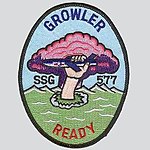 Regulus I missile aboard USS Growler at Pier 86 in New York, its museum ship home.
| |
| History | |
|---|---|
| Name | Growler |
| Namesake | Growler |
| Ordered | 31 July 1954 |
| Builder | Portsmouth Naval Shipyard |
| Laid down | 15 February 1955 |
| Launched | 5 April 1958 |
| Sponsored by | Mrs. Robert K. Byerts, widow of Commander Thomas B. Oakley, Jr. |
| Commissioned | 30 August 1958 |
| Decommissioned | 25 May 1964 |
| Stricken | 1 August 1980 |
| Homeport | Pearl Harbor, HI |
| Status | Museum ship at the Intrepid Sea, Air & Space Museum |
| Badge |  |
| General characteristics USS Growler SSG-577 | |
| Class and type | Grayback class submarine |
| Displacement | 2,110 tons light, 3,550 tons full, 1,440 tons dead |
| Length | 96.69 m (317 ft 3 in) overall, 96.3 m (316 ft) waterline |
| Beam | 8.2 m (27 ft) extreme, 7.9 m (26 ft) waterline |
| Draught | 5.7 m (19 ft) |
| Propulsion | 3 Fairbanks-Morse Diesel engines, 2 Elliott electric motors |
| Speed | 17 kn (20 mph; 31 km/h) surfaced, 12 kn (14 mph; 22 km/h) submerged |
| Test depth | 712 |
| Complement | 9 officers, 11 chief petty officers, 68 enlisted men |
| Armament |
|
USS Growler (SSG-577) was an early attempt by the U.S. Navy to field a cruise missile submarine that would provide a nuclear deterrent using its second series of cruise missiles. Built to deliver the Regulus I cruise missile, Growler was the second and final submarine of the Grayback class, fourth boat of the United States Navy to be named after the growler. Since Regulus I and Regulus II programs had problems, Growler and Grayback were the only two submarines built in this class as instead, the U.S. Navy veered its nuclear deterrence efforts into submarine launched ballistic missiles (SLBMs)—the Polaris missile program.
What makes Growler and her sister unusual was her nuclear armament, deployed on a conventional diesel-electric submarine. Her mission was to provide nuclear deterrent capability off the Pacific coast of the Soviet Union during peak years of the Cold War, from 1958 to 1964. Additionally, special forces missions were deployed from her torpedo tubes and nuclear hangar.
Decommissioned in 1964, she was put into service as a museum ship in 1988 as part of the Intrepid Sea, Air & Space Museum Complex in New York City.